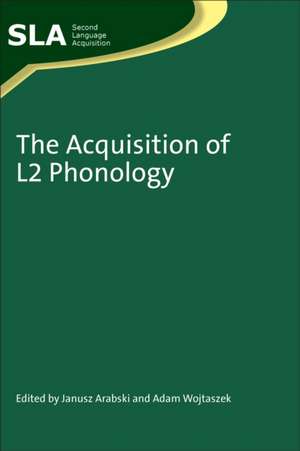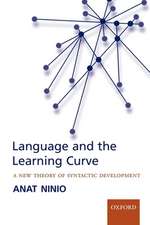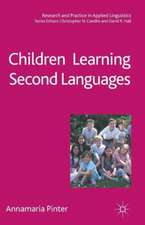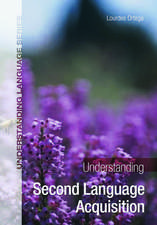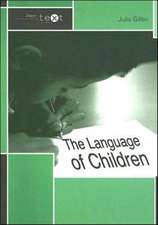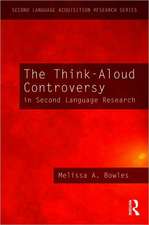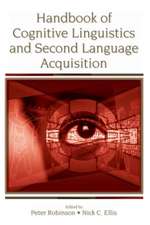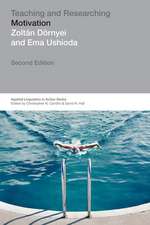The Acquisition of L2 Phonology: Second Language Acquisition
Editat de Janusz Arabski, Adam Wojtaszeken Limba Engleză Hardback – 6 iun 2011
Din seria Second Language Acquisition
- 18%
 Preț: 626.02 lei
Preț: 626.02 lei - 18%
 Preț: 626.75 lei
Preț: 626.75 lei -
 Preț: 311.97 lei
Preț: 311.97 lei - 18%
 Preț: 752.58 lei
Preț: 752.58 lei - 18%
 Preț: 626.28 lei
Preț: 626.28 lei -
 Preț: 191.10 lei
Preț: 191.10 lei -
 Preț: 230.53 lei
Preț: 230.53 lei -
 Preț: 312.89 lei
Preț: 312.89 lei -
 Preț: 229.99 lei
Preț: 229.99 lei -
 Preț: 229.33 lei
Preț: 229.33 lei -
 Preț: 274.96 lei
Preț: 274.96 lei -
 Preț: 275.50 lei
Preț: 275.50 lei -
 Preț: 311.43 lei
Preț: 311.43 lei -
 Preț: 229.50 lei
Preț: 229.50 lei - 18%
 Preț: 564.72 lei
Preț: 564.72 lei -
 Preț: 312.86 lei
Preț: 312.86 lei -
 Preț: 230.81 lei
Preț: 230.81 lei - 18%
 Preț: 564.63 lei
Preț: 564.63 lei -
 Preț: 274.68 lei
Preț: 274.68 lei -
 Preț: 311.92 lei
Preț: 311.92 lei - 18%
 Preț: 565.22 lei
Preț: 565.22 lei -
 Preț: 226.11 lei
Preț: 226.11 lei -
 Preț: 312.89 lei
Preț: 312.89 lei -
 Preț: 275.50 lei
Preț: 275.50 lei -
 Preț: 314.00 lei
Preț: 314.00 lei -
 Preț: 191.05 lei
Preț: 191.05 lei -
 Preț: 312.64 lei
Preț: 312.64 lei -
 Preț: 229.55 lei
Preț: 229.55 lei -
 Preț: 230.64 lei
Preț: 230.64 lei -
 Preț: 274.96 lei
Preț: 274.96 lei -
 Preț: 276.86 lei
Preț: 276.86 lei -
 Preț: 276.32 lei
Preț: 276.32 lei - 23%
 Preț: 779.43 lei
Preț: 779.43 lei - 23%
 Preț: 835.63 lei
Preț: 835.63 lei - 23%
 Preț: 837.13 lei
Preț: 837.13 lei -
 Preț: 380.43 lei
Preț: 380.43 lei -
 Preț: 300.24 lei
Preț: 300.24 lei - 23%
 Preț: 889.48 lei
Preț: 889.48 lei - 23%
 Preț: 829.71 lei
Preț: 829.71 lei - 23%
 Preț: 772.77 lei
Preț: 772.77 lei - 23%
 Preț: 772.77 lei
Preț: 772.77 lei - 23%
 Preț: 831.47 lei
Preț: 831.47 lei -
 Preț: 307.97 lei
Preț: 307.97 lei -
 Preț: 254.64 lei
Preț: 254.64 lei - 23%
 Preț: 775.73 lei
Preț: 775.73 lei -
 Preț: 377.55 lei
Preț: 377.55 lei -
 Preț: 373.68 lei
Preț: 373.68 lei
Preț: 774.69 lei
Preț vechi: 1006.09 lei
-23% Nou
Puncte Express: 1162
Preț estimativ în valută:
148.26€ • 154.21$ • 122.39£
148.26€ • 154.21$ • 122.39£
Carte tipărită la comandă
Livrare economică 14-28 aprilie
Preluare comenzi: 021 569.72.76
Specificații
ISBN-13: 9781847693754
ISBN-10: 184769375X
Pagini: 198
Ilustrații: Illustrations
Dimensiuni: 161 x 240 x 15 mm
Greutate: 0.47 kg
Editura: MULTILINGUAL MATTERS
Seria Second Language Acquisition
ISBN-10: 184769375X
Pagini: 198
Ilustrații: Illustrations
Dimensiuni: 161 x 240 x 15 mm
Greutate: 0.47 kg
Editura: MULTILINGUAL MATTERS
Seria Second Language Acquisition
Cuprins
Janusz Arabski and Adam Wojtaszek: Introduction to the volumePart 1: Phonetic analysis 1. Abeer Nasser Eddine: Second language acquisition: the articulation of vowels and the importance of tools in the learning process 2. Luo Xiaorong and Gao Jian: On phonetic negative transfer from Chinese to English 3. Linda Shockey: Understanding l 2 and the perspicacious Pole 4. Arkadiusz Rojczyk: Perception of the English Voice Onset Time continuum by Polish learners 5. Marta Nowacka: The productive and receptive acquisition of consonants and connected speech by Polish students of English Part II: Phonological analysis 6. Monika Kusiak: The role of phonological awareness in beginning reading: a cross-linguistic perspective 7. Anna Bloch-Rozmej: Aspects of phonological strength: evidence from language acquisition 8. Liliana Piasecka: The role of phonemic awareness in the development of l 1 and l 2 readingPart III: Pedagogical perspectives 9. Danuta Gabry?-Barker: Phonological issues in second language acquisition studies: focus areas and implications for FL instructional practices 10. Wies?awa Ferlacka and W?odzimierz Sobkowiak: PDI as a tool of phonetic enhancements to graded e-readers 11. Tammy Gregersen: Suprasegmentals: tools for increased language teacher effectiveness 12. Miros?aw Pawlak: Students' successes and failures in learning foreign language pronunciation: insights from diary data
Recenzii
Second language phonetics and phonology continue to attract researchers and teachers, theoreticians and practitioners, with the former marvelling at the degree of variability in the l 2 sound systems and the latter trying to find most effective ways of limiting this variability in their learners. As the field continues to grow, we need as much cooperation between the two approaches as possible. This volume offers a perfect balance between theory and practice, presenting original phonetics/phonology and classroom research. The applied approach that links all the contributions to the volume puts the sound system in the right perspective as an integral element of l 2 proficiency. The book will be of interest to anyone involved in researching and/or teaching English to speakers of other languages. Ewa Waniek-Klimczak, University of ?odz, PolandThis unique collection showcases the exciting work on acquisition that's been coming out of Poland for decades. What sets Arabski & Wojtaszek's edited volume apart from others on l 2 phonology is its wide appeal. There's something for everyone, from phonetic and phonological analyses of interlanguage data, to reading and phonological awareness, to paralinguistic cues in the classroom.Martha Young-Scholten, Newcastle University, UK
